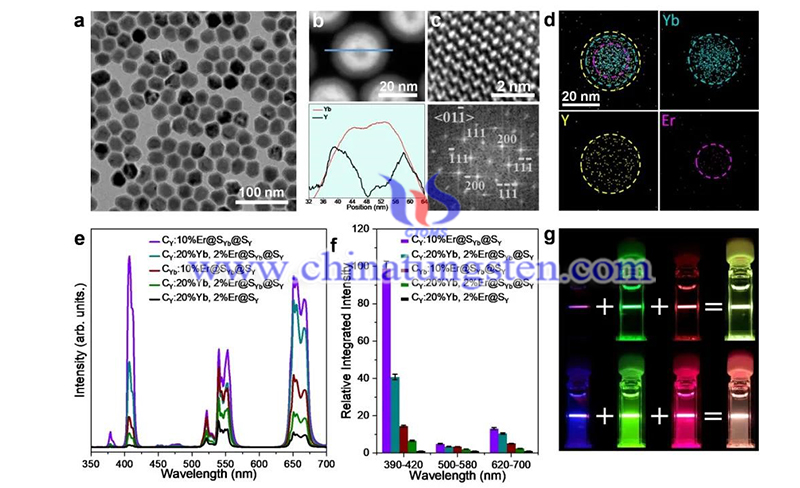HUST Makes Progress in Rare Earth Upconversion Luminescent Materials
- Details
- Category: Tungsten's News
- Published on Monday, 29 June 2020 19:39
In rare earth upconversion luminescent materials, the team of the Research Center for New Materials and Devices of the State Key Laboratory of Materials Forming and Mould Technology at the School of Materials Science and Technology, Huazhong University of Science and Technology (HUST) and the Institute of Chemistry of the Chinese Academy of Sciences jointly published the latest research result in Nature Communications. The paper titled "Enhancing multiphoton upconversion through interfacial energy transfer in multilayered nanoparticles".
The study jointly by the HUST was completed by the team of Professor Ying Ma of the College of Materials, Academician Jiannian, Yao of the Institute of Chemistry of the Chinese Academy of Sciences, Researcher Chuang Zhang, and Researcher Zhanjun Gu of the Institute of High Energy Physics of the Chinese Academy of Sciences and so on.

Up-conversion luminescence is anti-stokes luminescence, which is characterized by continuously absorbing two or more pump photons through the intermediate long-life energy state, and then emitting output at a wavelength shorter than the pump wavelength radiation. Up-conversion luminescence has potential applications in the fields of displays, solar cells, compact solid-state lasers, infrared quantum counter detectors, and temperature sensors. Up-conversion nanoparticles are usually composed of an inorganic matrix and rare earth doped ions embedded in it. NaYF4 is one of the matrix materials with the highest up-conversion luminous efficiency. To enhance the up-conversion luminous efficiency, rare earth ions as sensitizers and activators are usually Co-doping, such as NaYF4: Yb3+, Er3+ system, Er3+ as an activator, Yb3+ as a sensitizer.
The applications of lanthanide-doped upconversionnanocrystals in biological imaging, photonics, photovoltaics, and therapeutics have fuelled a growing demand for rational control over the emission profiles of the nanocrystals. A common strategy for tuning upconversion luminescence is to control the doping concentration of lanthanide ions. However, the phenomenon of concentration quenching of the excited state at high doping levels poses a significant constraint. Thus, the lanthanide ions have to be stringently kept at relatively low concentrations to minimize luminescence quenching.
To avoid the loss of excitation energy due to cross-relaxation as much as possible, in the sensitizer-activator co-doping system, the doping concentration of the activator usually could not exceed 2%. The lower doping concentration leads to lower luminous efficiency and intensity, severely limiting the application of up-conversion nanoparticles. Therefore, scientists have been devoted to the research work of improving the up-conversion luminescence efficiency of rare earth doped nanoparticles in recent years. According to the energy transfer mechanism and the luminescence quenching method, a new structure is designed to optimize the energy transfer path, reduce the non-radiative energy loss, overcome the concentration quenching effect of the co-doping system, and increase the doping concentration to prepare high brightness and high efficiency up-conversion Nanoparticles are the most important research targets in rare earth up-conversion nanomaterials.
In the HUST study, the cooperative team designed the multilayer structure (NaYF4: Er@NaYbF4@NaYF4) to spatially separate the sensitizer and activator from each other, successfully suppressing the cross-relaxation between the sensitizer and activator. Even at high doping concentration (Er3+ concentration is 10~50%), there is no obvious concentration quenching effect, and the multi-photon up-conversion luminescence is enhanced than the traditional co-doping system (NaYF4: Yb3+, Er3+@NaYF4) About 100 times. This result indicates that the interface energy transfer is an efficient upconversion process.
- Rare Earth Manufacturer & Supplier, Chinatungsten Online: www.chinatungsten.com
- Tungsten News & Prices of China Tungsten Industry Association: www.ctia.com.cn
- Molybdenum News & Price: news.molybdenum.com.cn
- Tel.: 86 592 5129696; Fax: 86 592 5129797; Email: sales@chinatungsten.com



 sales@chinatungsten.com
sales@chinatungsten.com